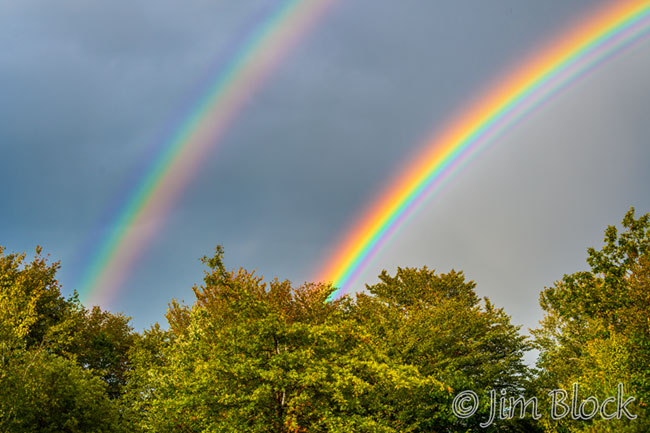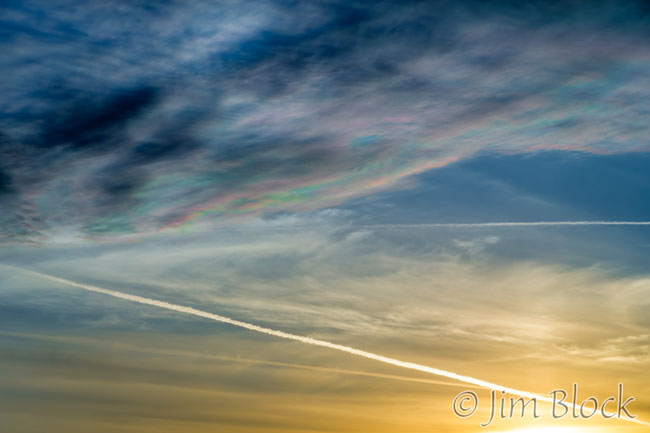This blog was first published in 2015, but I have kept adding new photos to it and will likely continue to do so.
Look up. There are amazing light shows in the sky. Some you can plan to see but many happen at unexpected times.
I’ve never viewed myself as a landscape photographer. I do have photos of perhaps a dozen covered bridges. Eleven of them have been published. However, none are traditional calendar material. I have photographed a bit over a dozen lighthouses. Three of them are not on the ocean. These inland lighthouses are on Lake Sunapee and can be seen on my “Published Photos” web pages.
A favorite ocean lighthouse photo is below, the Milky Way over Cape Neddick Light (“Nubble Light”). This is a 4-shot panorama with a 14mm lens on a full frame body, shot a ISO 1600, f/2.8, and 25 seconds. The yellow light on both sides is not from the sun, which will eventually rise roughly behind the lighthouse. The bright “star” to the right of the lighthouse is Venus.
You can click this image to get to a site where you can zoom way in then pan around. When you get there, click the double arrow above the image on the right to see it full frame. Please wait for the resolution to download. You can use the + and – keys to zoom and the arrow keys to scroll. Or use the scroll wheel to zoom and the left mouse to drag.

I like to photograph almost anything, especially people and nature/wildlife, and I rarely plan. I guess I have more of a photojournalistic style in most of what I photograph. I’m basically an opportunist, who gets lucky by being out in the world a lot.
My Planning
Most often I get a special photo by exploring the world rather than traveling to iconic spots to get a beautiful photo that is similar and likely inferior to many beautiful photos others have taken. Only a few of the photos here were “planned,” and even for the planned photos, the planning was minimal.
For the photo above the planning happened a few hours earlier when I decided to head to a nice spot just in case I might find something good. I took my one trip to the coast the winter of 2014 to try my hand at the snowy owls. Late in the day I realized I needed a place to sleep for the night. “Hey, why not head up to York—haven’t been there for years—and maybe I’ll find something to photograph.” I woke up in the middle of the night and headed to Nubble – a place I visited once or twice long ago back in the film days.
Getting Lucky
Most of my photos are the result of “getting lucky.” The way one gets lucky is to spend a lot of time in places where luck might happen. “The harder I work, the luckier I get.”
My day and night sky photos are no different. Few were planned; many were lucky. Here are some examples of the Celestial Lights you might photograph if you look upward and are prepared. I have included many links for those who might want to see more and maybe learn by seeing photos of others – a great way to learn in my opinion, if you also photograph your own vision rather than copy. Click on the highlighted words throughout this article to get to more photos and details that might interest or motivate you.
The Moon
The moon is a popular subject for many. I’ve taken my share of moon photos, but I don’t recall any with an ocean lighthouse or covered bridge. Maybe some time I will plan one.
Photos of the moon are best when there are other elements in the photo. Here are two examples. Ama Dablam (22,349 ft), “the Mother’s Necklace”, is one of the most beautiful mountains in Nepal with its long ridges on each side like the arms of a mother protecting her child.


If you would like to see more and perhaps learn about using the moon as an object in your photos, you can read a two-part article with tips on photographing the moon.
Milky Way
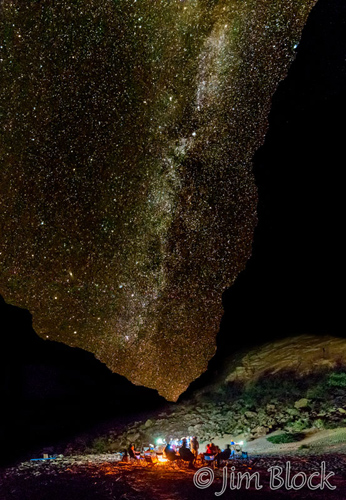
The Milky Way is getting easier and easier to photograph with the very sensitive, low noise, current generation digital cameras and many apps that let you PLAN your shots. But few of my Milky Way photos have been planned. Some of my favorites were made during an 18-day trip down the Colorado River through the Grand Canyon on wooden dories. One of my favorites is to the right. I managed to get it without my full-frame camera and fast lens.
This photo was taken near the end of this fantastic trip with O.A.R.S. at a camp often called “Love Nest”. I took multiple shots to get the Milky Way and then another exposure for the camp fire. Conditions were great because this was late October, so the sun set early and I could get to bed under the stars without a tent at a very reasonable hour. I’m a morning person. This photo was shot at 7:34 pm, pretty close to my bedtime, especially after a long and exciting day on the river.
One of my really getting lucky shots was when I decided to head out on Lake Sunapee in the middle of the night to try a panorama of the Milky Way. I got it, but I also got something quite unexpected—the Northern Lights in the images when I swung to the north as seen in the photo below.

Amazingly, exactly one year after I took the photo above, the same thing happened on a trip down the Yampa River in Utah. I was there photographing the 50th Anniversary of the Warm Springs disaster for O.A.R.S.

One time with only a few hours of “planning” I made a time-lapse of the Milky Way moving on a partly cloudy night. (If you haven’t figured it out yet, click the highlighted words in the preceding sentence to see the time-lapse.)
Lunar Eclipse
On the night of September 27-28, 2015 a lunar eclipse coincided with a “super moon”. I did not travel to find a lighthouse, covered bridge, or barn to put in the foreground. Instead I decided to try something different in my backyard when I realized that at full eclipse the moon would be so dark the Milky Way would be visible. The background image here with the Milky Way is a 3-shot panorama. The bright “star” on the left is actually the moon near full eclipse. The superimposed “blood moon” photo was taken at about the same time.

In the early morning hours of a cold March 14, 2025, we had another total lunar eclipse and blood moon. I originally planned to go to the site of an old barn I was going to use in the foreground for a combo MW and blood moon image. But I realized that this year the moon would be in the south and the MW in the north so it would not work. I’m glad I stayed home because I got very cold taking the photos, even with a periodic retreat to indoors and the stove for warming my hands.


Comet NEOWISE
Comet NEOWISE, visible with the naked eye, visited us in mid-July, 2020. I was fortunate enough to photograph it two nights without much planning. Here a three shot “panorama” and a cropped version of it. In the cropped version you might be able to see the two tails of the comet.
The blue ion tail on the left points directly away from the sun and is pushed out by the flowing and charged solar wind. Structure in the ion tail comes from different rates of expelled blue-glowing ions from the comet’s nucleus, as well as the complex structure of our sun’s wind. The main dust tail is pushed out by sunlight, but curves as heavier dust particles are better able to resist this light pressure and continue along a solar orbit. You can see more photos of this comet if you CLICK HERE.


Rainbows
Rainbows are another classic subject. Unlike the other Celestial Lights that are described below, rainbows and glories are seen with your back to the sun. They are centered around the anti-solar point, a point directly opposite the sun through your head. Rainbows are seen along an arc 42 degrees from the anti-solar point. Therefore, they can only be seen when the sun is fairly low in the sky. At midday the rainbow is below the horizon.
Rainbows are rarely anticipated but much appreciated when they happen. Here are four, one when I was in the White Mountains to photograph birds, one when a neighbor alerted me to one over a New Hampshire lake we were staying on, one from St John, USVI, and finally one from a hilltop in the Hanover, NH area. All but the first of these (with the White Mountains in the background) were 4 to 7 shot panoramas.
Fogbows
Closely related to rainbows, fogbows happen with the sun low in the sky behind the viewer. The higher the sun, the lower the fogbow. Because of the very small size of water droplets that cause fog, a fogbow has only very weak colors. In many cases, when the droplets are very small, fogbows appear white, and are therefore sometimes called “white rainbows”.
Here is a fogbow that I photographed on a beach in the Snaefellsnes Peninsula of Iceland.
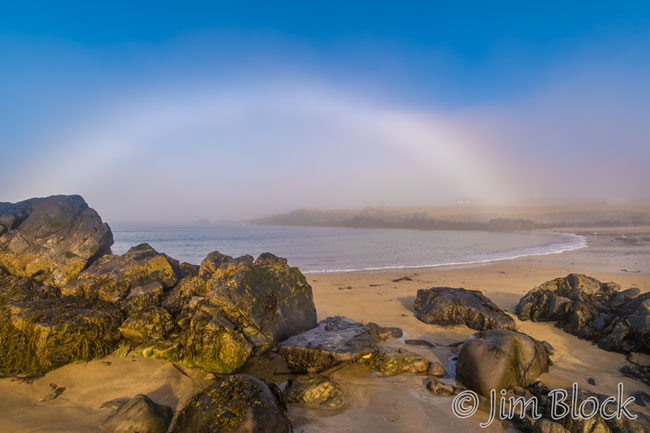
Much closer to home, here is one over Lake Mascoma from the Shaker Bridge in Enfield, NH.

Glories
Glories are most frequently seen from an airplane on the clouds below. A glory involves refraction, reflections, and diffraction — they all get into the act. But no matter. It pays to occasionally look for them when flying in the sun over a cloud layer — and have a camera handy. I photographed the glory below over the Atlantic returning from my first trip to Nepal.

2024 Solar Eclipse
Here is a sequence approaching totality, at totality, and just beyond it. The first four were taken about 20 minutes apart. The last three about 10 minutes apart. In the photo at totality you might be able to spot the red of a large prominence, a plasma structure on the sun.

As the sun is entering and leaving totality, a “diamond ring” appears briefly. Here it is both times.


In the photos above you can see red prominences Prominences are plasma structures that form over timescales of about a day. Stable prominences may persist in the corona for several months, looping hundreds of thousands of miles into space, according to NASA. Here is a closer view of one of them.

At totality the corona was beautiful. But at totality it is visible as seen in my photo below.

Sunspots
During my fourth visit to Monhegan Island, we had a few days when smoke from Canadian wildfires caused the sun to be hazy and colorful. The sun’s weakened brightness allowed sunspots to seen though my “bird lens”. Since I was using a mirrorless camera, I was not looking at the sun through the lens but at an image on a monitor, so I did not have to worry about harming my eye. Photos several different days clearly showed that the sunspots move, proving the sun rotates.

Sun Pillars

Hexagonal plates of ice crystals falling like leaves in the sky reflect light from the sun and form a sun pillar, vertically above or below the sun. This often happens at sunrise or sunset and the results can be quite colorful. The photo on the right was taken at sunrise. The peak on the left in the sunset photo below is Mount Ascutney.


Sun Dogs
A Sun Dog is a “parhelion,” a colored, luminous spot on either or both sides of the sun formed by refraction through hexagonal ice crystal plates falling with their long axes vertical. I photographed a pair shortly after sunrise when I rode my mountain bike into Cherry Pond at the Pondicherry NWR in NH.

Arcs and Halos
Arcs and Halos are also caused by sunlight refracting off ice crystals in the sky. The trio of images below was taken around noon in Arizona. The top image shows both a Circumhorizontal Arc and 22-degree Halo above it. The middle photo shows a Circumhorizontal Arc. The bottom photo shows what we referred to as the stairway to heaven—clouds leading to the arc. This amazing light show lasted for an hour.



22 degree halo over Sunapee, NH
While on a hike with the Ausbon Sargent Land Preservation Trust on a newly conserved property in Sunapee, I spotted a 22 degree halo around the sun. The folks I was walking with called it a sun dog, a common error. Technically sun dogs are the two bright and often colorful spots that sometime appear near the halo on each side of the sun. Sun dogs can appear alone, without a visible halo. In this case there was a halo without visible sun dogs. Both are caused by the refraction of light from plate-shaped hexagonal ice crystals falling through the atmosphere.
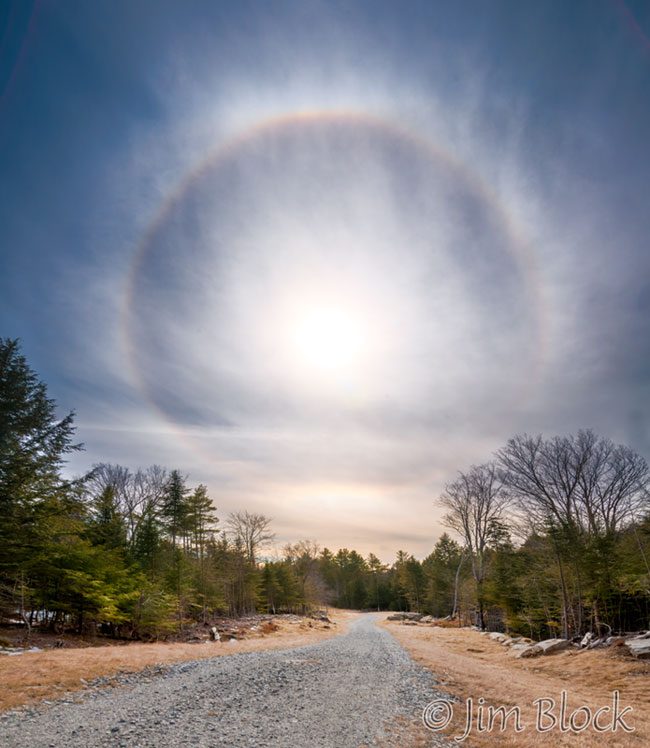
22 degree halo over Etna, NH
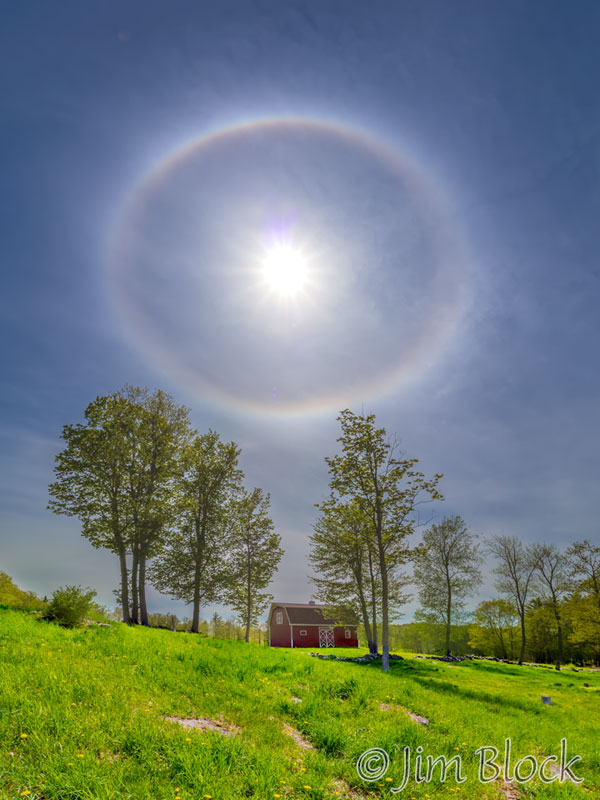 As Jann and I were nearing the end of a favorite loop hike in Etna, I spotted a 22 degree halo. The halo was strong and dramatic. The camera I was carrying had a long zoom and therefore could not come close to capturing the halo with a single shot. So I tried my iPhone, and even that was not wide enough to capture it in a single photo.
As Jann and I were nearing the end of a favorite loop hike in Etna, I spotted a 22 degree halo. The halo was strong and dramatic. The camera I was carrying had a long zoom and therefore could not come close to capturing the halo with a single shot. So I tried my iPhone, and even that was not wide enough to capture it in a single photo.
We hustled back to our car. I grabbed a very wide angle lens (14-28mm eq.) and took a few photos of the event. I was not worried about my eyes because I was not looking at the sun directly through the lens but on the camera monitor.
I knew that, although I captured the halo, the photo would be a bit sterile with just the sun and its surrounding halo. So we drove about a mile to a spot with something I could use as a foreground. Just as with sunrises or sunsets, photos are better with some interesting foreground rather than just pretty colored clouds.
The photo below makes it look like the sun was lower in the sky than it actually was. That is because I was down a small hill shooting up at the barn and trees.
Often these events are very transitory. Poof and they are gone. Did I really see it? Amazingly, this one lasted well over an hour.
22 degree halo around the moon
I was up at 4 am December 4, 2020, a very rough year. I happened to look at the sky. I saw a dramatic 22° halo around the moon. I have seen and photographed 22 degree halos before around both the sun and moon, but it is always nice to experience another one.
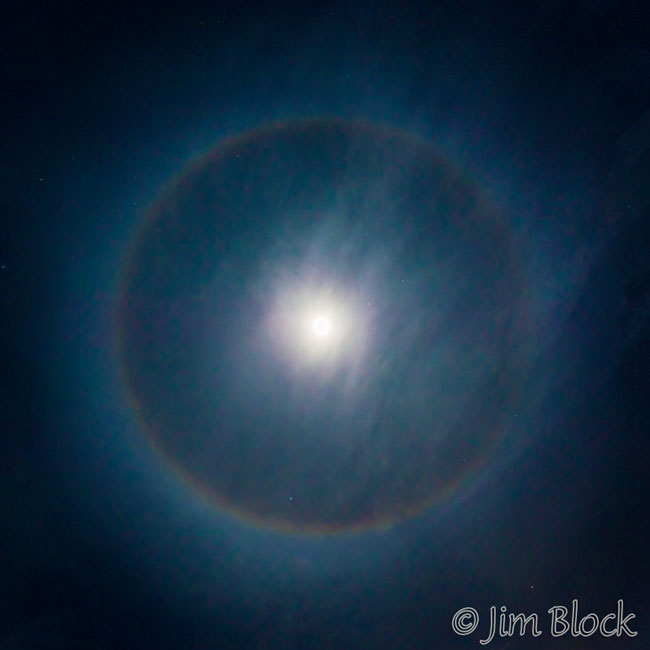
A 22° halo is produced by hexagonal ice crystals in the sky as light refracts through one crystal face and out another face. If you draw a regular hexagonal figure you will note that two sides, which are neither adjacent nor opposite, are 60° oriented from each other. The crystal forms a series of truncated 60° prisms. Light coming in one side is refracted and some of it exits the side which is neither adjacent nor opposite and again changes its direction such that the incoming beam is affectively diverted by 22°. This means that only the light refracted from those crystals which lie at around a 22° angle away from the sun as viewed by the observer will reach the observer’s eyes or camera.
The ring of light or halo is sometimes red on the inside, but often it appears mostly white. Some of the rays are bent at greater angles and this accounts for the fading from light to dark outside the rim. No light is bent less than 22°. Thus the halo’s center is dark.
Sun Dogs, Halo, and Pillar in NH
An amazing light show appeared, faded, then reappeared in greater glory along I-89 in Grantham, NH some years ago. We saw a pair of dogs as well as a faint 22 degree halo through them. I pulled over again and shot a series of photos at varying exposures. I wish I would have had time to change to a wider lens. But we are thankful that we could witness the celestial show on a brilliant, below zero degree Fahrenheit morning.

From “Kaleidoscope Sky” by Tim Herd, a 22 degree halo is produced by the refraction of light through faces of ice crystals. The light from the cloud of falling crystals “is deviated a minimum of about 22 degrees, varying slightly according to wavelength, to create a ring of color about 22 degree from the Sun or Moon, with red on the inside. Some rays bend at greater angles and account for the fading, outward edge of the halo extending up to 50 degrees. No light is bent less than 22 degrees, which creates the halo’s dark center.”
The vertical flare extending above and below the sun is a sun pillar, also caused by falling ice crystals. I do not yet understand the narrow circular arc at the edges of the photo. It is probably caused by an optical effect in the lens. I admit I did not notice it when I took the photos–but I was in a hurry and cars were whizzing by, in spite of the fact that the road looks empty in this photo.
Iridescence
Crossing a low pass on the second of three cold and very windy days in the Westfjords of Iceland, we thought we saw some color in the clouds below the sun. Was it real or a fluke of our sunglasses? Fortunately Marc was driving, and I had a camera on my lap. I got off a few quick shots as we kept moving. Here you can see the color in the clouds to the left of center.

I zoomed in and got a few more photos. What we were seeing is Iridescence in the clouds. Iridescent clouds are a diffraction phenomenon caused by small water droplets or small ice crystals individually scattering light. The colors are usually pastel pinks, greens, and blues arranged in smudges or orderly bands, especially at the clouds’ edges. The colors can sometimes be very vivid.

After adding these two images I remembered a wonderful show of clouds, patterns, and color that lasted for over an hour as we hiked from Khumjung to Namche in Nepal near the end of a four-week trip from Jiri to Kala Pattar and Everest Base Camp. The wind behind Thamserku (21,729 ft) created amazing cloud formations, and the sun added Iridescence to the clouds. Here are three photos I took.
A friend and I had a nice display of iridescent clouds only a few miles from my home on a mid-February afternoon.
Iridescent clouds can be seen at any time during the year, but they are more common in autumn and early winter. You can learn to look for this phenomenon, carefully shielding your eyes from the sun, by recognizing the cloud types that tend to produce cloud iridescence. Better yet, use Live View or a mirrorless camera to protect your eyes. Sometimes the sun is partly hidden by the clouds, which helps, as in this photo taken October 20, 2018.

Perhaps the loveliest iridescence are produced by cirrus clouds, which are generally characterized by thin, wispy strands, like in the photo below from Monhegan Island in late September 2018. Part of the sun was behind the Monhegan Community Church and most of the rest of the sun was just out of the frame.

Cirrocumulus and altocumulus clouds show lovely iridescent hues arranged in stripes, bands, and “eyes”, similar to the photo below taken November 12, 2018.
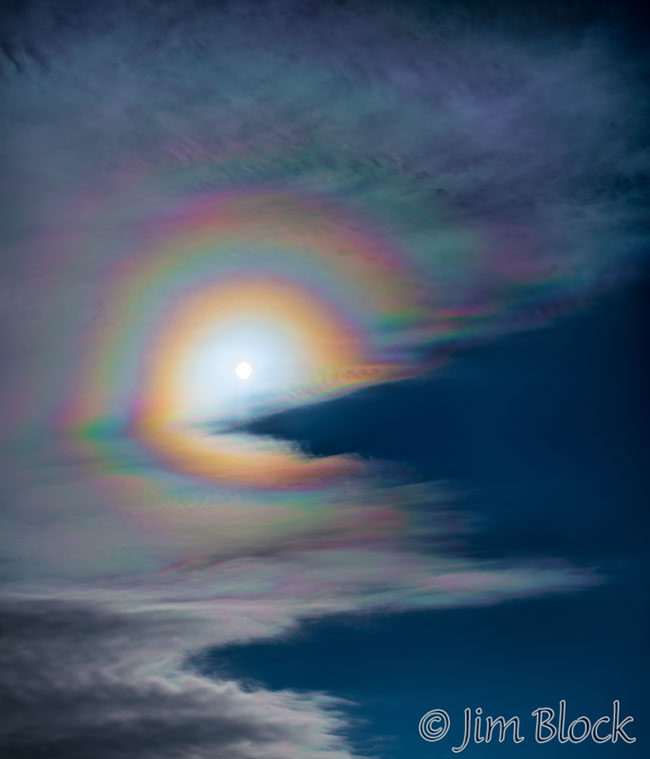
Iridescent clouds can also be seen around the moon as in this photo taken from my back deck one 30 degree Fahrenheit morning in November.

Crepuscular Rays
Crepuscular Rays, sometimes called “god beams,” are alternating light and dark bands of rays and shadows caused by clouds intercepting sunlight. They appear to diverge in a fan-like array from the sun’s position even though they are actually parallel beams of light. This illusion of divergence is caused by perspective.
Below is a pair of images. The first is from New Hampshire. The second shows crepuscular-like rays over mountain peaks in the Khumbu region of Nepal. I did not discover until I wrote this piece that a nearly identical photo, taken 8 years earlier than mine, was published in an excellent book by Tim Herd that describes Celestial Lights in intricate detail. This photo was taken the first morning of a trek from Lukla to Phaplu. Along the way we delivered 200 pounds of fleece jackets to school children. This is a region hit hard by the strong earthquakes in 2015.


Sun Star

Sun stars are caused by the bending of light (diffraction) around the edges of your lens’ diaphragm (aperture). For the same reason that lenses are less sharp at f/22 than at intermediate apertures, sun stars are best created using small apertures, which means large f/numbers and wide angle lenses. The smaller the “hole” the more edge there is and the more diffraction there is.
Sun stars are often best when the sun just peeks through a small opening or around a corner, as in the photo to the right.


Transit of Venus
Another mostly unplanned series of photos were made June 5, 2012. I knew this Celestial Light show was happening for the only time in the remainder of my life — Venus crossing in front of the sun.
People who planned had a very dark filter to cover their lenses to protect their eyes. My good friend, Ed in Vermont, did. He was well prepared as usual, but it rained at his location and he only got a few not-so-great images. Without a dark filter, I got lucky when clouds moved across the sun just at the right time to get some shots without going blind. Below is one. Venus is the tiny dot in front of the sun near the top. The other smaller spots are sun spots, not dust on my lens.

A Puzzle for You
Here is a photo I took around 8 AM while waiting to board a flight from the amazing airport in Lukla (9,200 ft) for a flight to Kathmandu, Nepal. The shadow you see on the clouds is clearly from the mountains. But the sun is behind the mountains. How can this be? There is only one obviously correct answer. Incidentally, if you study this photo you can see a bit of cloud iridescence in the bright region.








